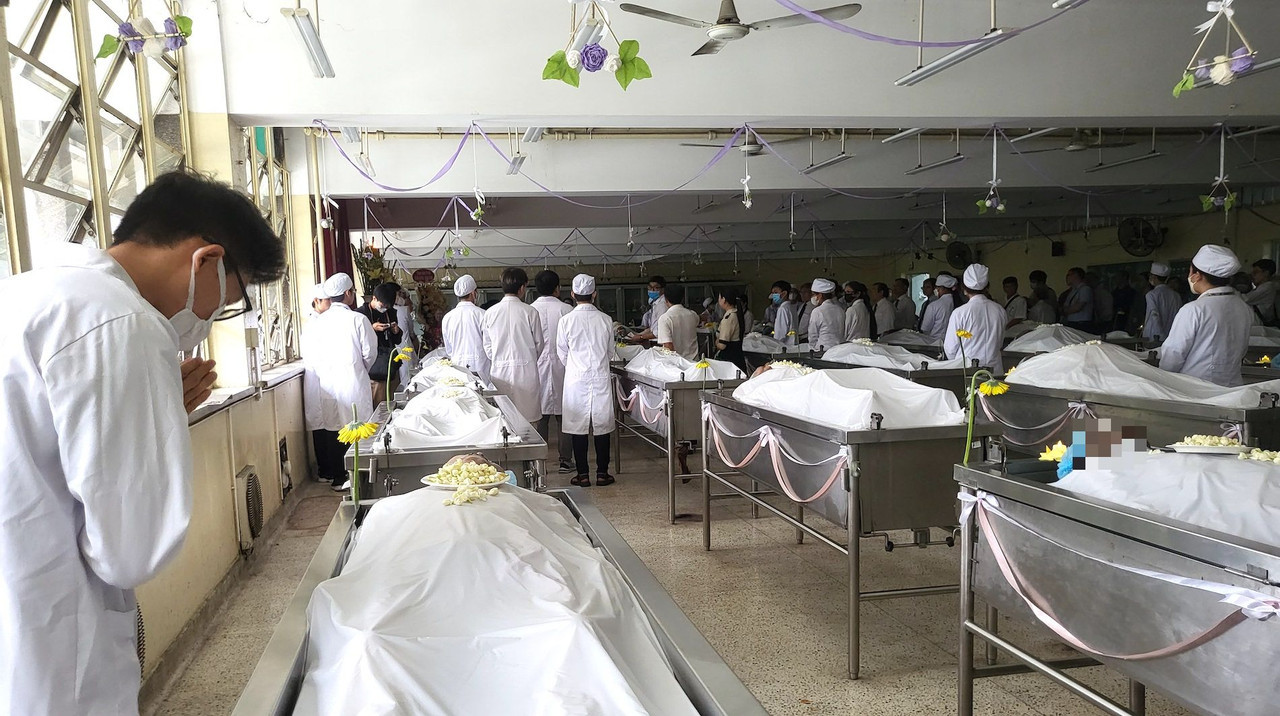
He hoped the 12-year-old understood the decision of the father and grandmother to donate their bodies to science.
Seven years ago, H’s mother passed away at the age of 67, H called the anatomy department of the HCM City University of Medicine and Pharmacy, informed them that his mother was dead and requested the university to send their staff to his home and receive the corpse.
H’s mother was the first person of the family who did the good deed.
On January 23, during the ceremony expressing deep gratitude to people who donate their bodies to education and scientific research, H was sitting quietly, listening to the funeral oration and thanks from the students and teachers of the medical school. The 12-year-old boy was seen sitting next to him, decent and dignified, waiting for his turn to visit his deceased grandmother.
“My mother and I believe that if we can do anything to help people, we will do it. I myself also decided to donate my body after my death. I have brought my son to the Macchabée (the ceremony honoring those who donate their dead bodies to science), hoping that he can understand our decisions,” H said.
Joining the stream of people from the Great Hall, H and other people slowly entered the mortuary room of the anatomy department. The short and familiar path for medical school students was solemnly decorated that day. Fifty-two corpses were lying under white cloth, fragrant flowers and prayers.
With the assistance of students, Dang Quoc Cuong, 64, in HCM City, and his wife, came for the dead body of their daughter. The girl with the beautiful name Phuc Loc passed away in 2019 because of a critical disease while she was studying medicine at Tan Tao University.
Cuong told reporters that after the girl began studying anatomy, she had the intention of donating her body after the death. The girl tried to persuade her friends to register their donation, but some were not willing to do this. Then his daughter asked: “Why can we conduct surgery on them, but we dare not donate our dead bodies?”.
After Phuc Loc passed away, her parents fulfilled her wish and donated her body to the medical school.
“We also visited our daughter last year. Every time when I pass by here, I stop for some minutes and read prayers for my children and those lying here," Cuong said.
In another place, Hoang, 38, in HCM City, gave his mother a bouquet of flowers after many years of separation. “Donating her body to science was the will of my mother. I am the person helping her wish come true,” Hoang said.
Dr Nguyen Hoang Vu, head of the Anatomy Department, said the donated corpses are the first "quiet teachers" of medical students. Macchabées are the first lessons about medical ethics for future doctors.
Vu stressed that the experience in practicing with dead bodies will be very useful for doctors. Even though technologies now are developed and students can study with simulated models and modern IT software, practicing on dead bodies is a must.
In 2023 alone, the anatomy department received 1,656 individuals who came to register body donations and received 32 corpses.
Since the inception, 34,514 individual have registered body donations and 909 corpses have been received. After using the bodies for teaching and researching, 128 of them are preserved.
In Doctor Vu’s office, there is an altar with the portrait of the person credited with restoring the Macchabée ceremony at the HCM City University of Medicine and Pharmacy – Nguyen Quang Quyen, former head of the Department of Anatomy.
In Vietnam, in the 1990s, medical schools all lacked corpses for students to practice on. There was a very low number of unclaimed dead bodies.
In 1990, Professor Nguyen Quang Quyen, a respected teacher of many generations of medical students, who was then Head of the Department of Anatomy, initiated a call for body donation and the restoration of the Macchabée ceremony. In 1993, the first body donated was from Nguyen Duc Minh, a blind man.
After the call from Quyen, more people registered to donate dead bodies to science. The corpses, after being used for teaching, studying and research (after one year), are incinerated and the ashes are given back to their families.
"When Quyen posted the news in the newspaper, people started submitting applications more and more. After being used for study and research, the bodies are cremated and sent to their families."
Linh Giao